Telescope
Makers
"O Telescope... instrument of knowledge, more precious than any sceptre."
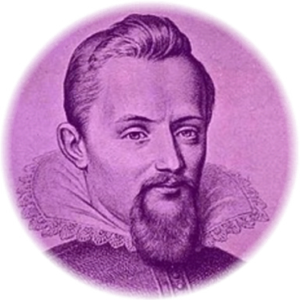
Johannes Kepler
Mathemetician,
Formulated the “Three Laws of Planetary Motion”
Media Credit:
Biblioteca Europea di Informazione e Cultura,
Public domain, via Wikimedia Commons
"O Telescope... instrument of knowledge, more precious than any sceptre."

Johannes Kepler
Mathemetician,
Formulated the “Three Laws of Planetary Motion”
Media Credit:
Biblioteca Europea di Informazione e Cultura,
Public domain, via Wikimedia Commons
A Talented Trio with Stony Ridge Ties
The instruments on this page were made by some of the Founding members of SRO, principally George Carroll, with other examples by John Terlep and Roy Cook. They feature a range of sizes and optical configurations but each required considerable skills to conceive and execute. Telescopes that are well made and cared for can last for generations, and this applies to amateur-owned as much as it does to that held by institutions.
In terms of capability, the distinctions between the two in terms of capability have become somewhat blurred over the last few decades or so. This is largely due to the availability of relatively large reflector telescopes and the explosive growth of digital electronics which has affected everything from the automation of telescope mounts to the production of stunning imagery of all types of objects, even with otherwise modest equipment.
The ones pictured here were from a golden age of amateur astronomy that began around the time of the Hale telescope’s commissioning in the late ’40s and lasting for about twenty years. It was a period of time sparked by the post war optimism of a burgeoning middle class and then fueled by the space race which reached its zenith in 1969 with the flight of Apollo 11. Superbly crafted telescopes of this era could be outfitted with clock drives, setting circles, guide scopes, and multiple optical configurations, depending on needs of the customer and the capabilities of the maker. Several wonderful examples are shown below.
4-inch Refractor
- - -
George Carroll
This telescope was an early (1949?) creation and was to have a life both exquisite and tragic. It is seen below with its original owner Les Mawhinney, former president of the Los Angeles Astronomical Society (LAAS).
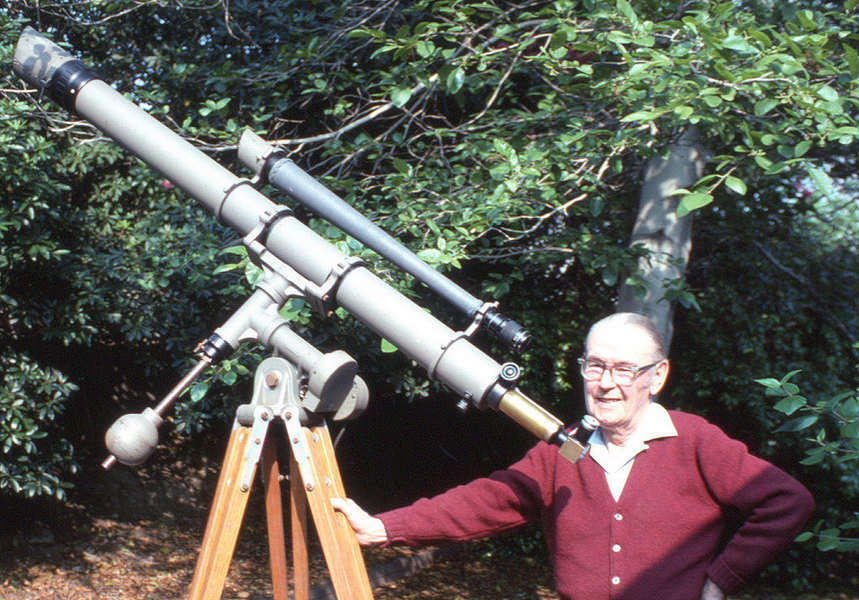

Mike O’Neal
It was later donated to the Society in 1976 and then moved north. Eventually, it found a home at the Society’s dark sky near Lockwood Valley, California.
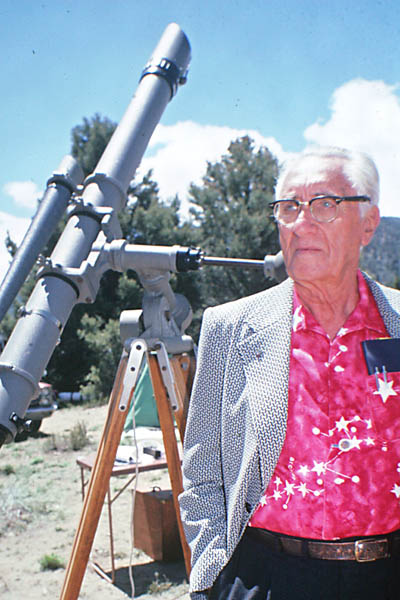
Creation and Creator
The builder, George Carroll, with the LAAS scope at the Riverside Telescope Makers Convention (RTMC) in 1980. This telescope was used and tested by two optics experts, Tom Cave and Thomas Cragg, and judged to be one of the finest used by either, rivaling any Alvan Clark instrument of equal aperture.
Sadly, Lew Chilton of the LAAS reported that the object glass from this refractor was stolen within a year or two after this photo was taken.

Creation and Creator
The builder, George Carroll, with the LAAS scope at the Riverside Telescope Makers Convention (RTMC) in 1980. This telescope was used and tested by two optics experts, Tom Cave and Thomas Cragg, and judged to be one of the finest used by either, rivaling any Alvan Clark instrument of equal aperture.
Sadly, Lew Chilton of the LAAS reported that the object glass from this refractor was stolen within a year or two after this photo was taken.
4-inch Astrograph
- - -
Roy Cook
This 4-inch astrograph was made in 1953. It is shown here in the optical shop of astronomer and telescope collector, John W. Briggs. “Astrograph” optics are photographically fast, able to capture wider fields of view in shorter amounts of time than their long focus cousins which are better suited for visual purposes.
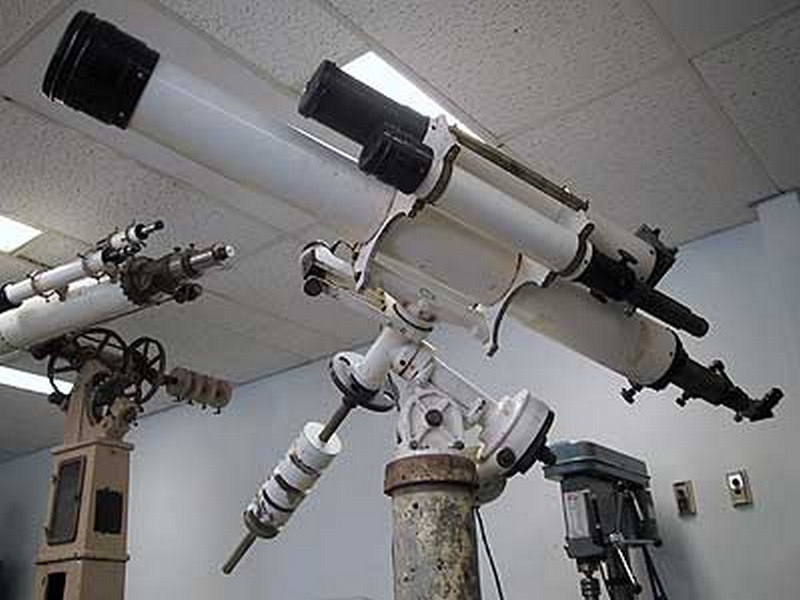

Mike O’Neal
The telescope was built by Roy Cook using the facilities of Carroll Astronomical Instruments, the company owned and operated by fellow SRO principal, George Carroll. The customer was George Moyen, another of Stony Ridge’s founding members.
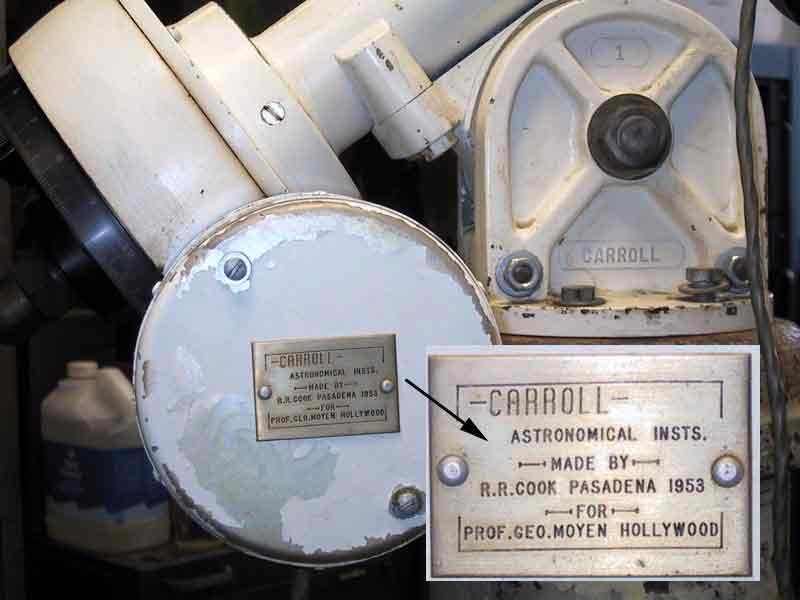

12-inch Cassegrain
- - -
John Terlep, George Carroll
A 12-inch Cassegrain optical tube assembly built by John Terlep; mount by George Carroll. This instrument was donated to Stony Ridge Observatory by the family of John Terlep.
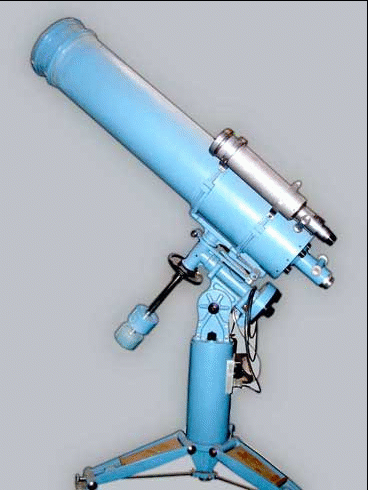
Cassegrain Optical Design
Fabricating a telescope like this requires the optician to figure two precision surfaces, one concave (the main "objective" mirror) and the other convex (the secondary).
In the "classic" case, the large, light gathering mirror at the bottom of the tube has a cross-section shaped like a parabola that has been revolved around an axis. Light entering the top of the tube (magenta dotted line) strikes the mirror and is reflected (yellow) back toward the smaller secondary where it is reflected yet again (red). The light finally comes to a focus in back of the tube after passing through a hole in the main mirror.
The hyperbolic surface of the secondary mirror results in a light cone with a long focal length yet able to be mounted in a tube of modest length. Users of these telescopes were often primarily interested in lunar or planetary observations where a narrow field of view with high magnification is sought.
Several variations / extensions of this basic configuration have been devised, some quite commonplace (Schmidt-Cassegrains, for example) with others decidedly more exotic, such as the Dall-Kirkham, among others.

Cassegrain Optical Design
Fabricating a telescope like this requires the optician to figure two precision surfaces, one concave (the main "objective" mirror) and the other convex (the secondary).
In the "classic" case, the large, light gathering mirror at the bottom of the tube has a cross-section shaped like a parabola that has been revolved around an axis. Light entering the top of the tube (magenta dotted line) strikes the mirror and is reflected (yellow) back toward the smaller secondary where it is reflected yet again (red). The light finally comes to a focus in back of the tube after passing through a hole in the main mirror.
The hyperbolic surface of the secondary mirror results in a light cone with a long focal length yet able to be mounted in a tube of modest length. Users of these telescopes were often primarily interested in lunar or planetary observations where a narrow field of view with high magnification is sought.
Several variations / extensions of this basic configuration have been devised, some quite commonplace (Schmidt-Cassegrains, for example) with others decidedly more exotic, such as the Dall-Kirkham, among others.
12-inch Cassegrain
- - -
George Carroll
This Carroll creation is a beautiful example of what was then the “state-of-the-art” for an amateur fortunate enough to afford it. Telescopes of this size, with a mirror a foot in diameter, were well beyond the means of most enthusiasts who would be far more likely to purchase a small refractor of 60 mm aperture, a 4.5 inch reflector or, luckier still, a 6 incher.
This 12-inch telescope could gather roughly 4 times the light of a 6 inch (area varies as the square of the radius: 6^2 =36; 3^2 = 9). Being two times the diameter of the smaller optic, it could resolve details twice as well versus the smaller mirror.
A Well-Equipped Amateur Telescope (c 1960s-70s)
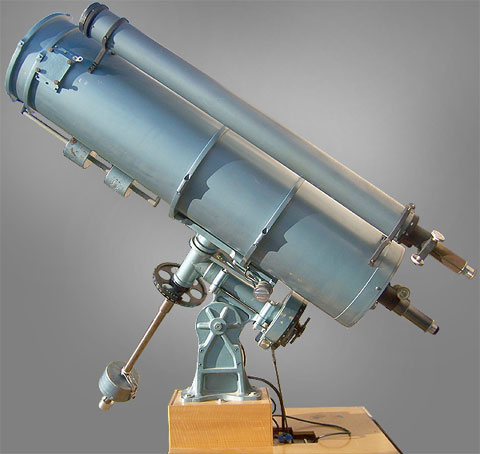











As a young boy, George Carroll became so smitten with telescopes after looking through one that he eventually went on to make them, this being a premier example.
It incorporates all of the features that an advanced amateur would want in a scope of this type: a dual-use optical tube here configured as a Cassegrain.
This telescope was eventually housed in a private observatory near Escondido, California. The photo below shows it there and much adapted from its original state. Amateurs love to incorporate advances in technology, many brought about by the revolution in modern electronics, as perhaps evidenced by the component at the Cassegrain focus on the back of the tube.
Computer control and “smart,” stand-alone systems have replaced many of the features listed above and have altered the experience of new observers. For instance, “star-hopping” with a chart in one hand and the other pushing on the telescope may no longer be a required skill as even entry level rigs have often incorporated some form of automatic pointing.
Advancements like these can greatly improve the efficiency and satisfaction of the observer willing to take full advantage of them. It could be argued that those best able to do so are the ones who learned to do it “the hard way” and can better appreciate what modern technology brings to the table. On the flip side, new tools are, quite often, necessarily more complex and require additional investment in time and self-study. In short, youngish or older, there is opportunity for growth on a continuing basis as astronomy moves forward, great news that keeps this pursuit both fresh and viable for observers of all ages.
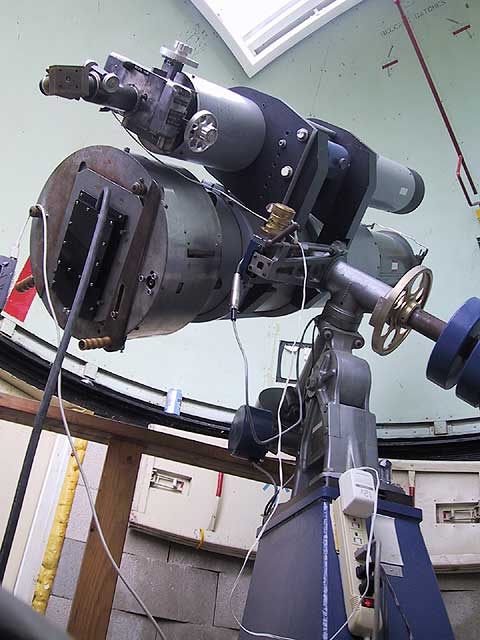

The refractor appears to be fitted with a filar micrometer, a device which can measure lateral distances of objects in the focal plane. This is useful for collecting astrometric (position) data for, among other things, double stars.
Not surprisingly, digital imaging and computerization in general has all but replaced the need for components like this, once a prized accessory for research but now more at home on a shelf, in a storage room, or at a museum. It is far from the only casualty – many were crushed under the boot of innovation in its relentless advance, a forward march with little regard for the romance of a bygone era.
16.5-inch Cassegrain
- - -
George Carroll
The first large reflector built by George Carroll was this one. He donated it to Westmont College in Santa Barbara, California in 1957. Work on Stony Ridge’s 30-inch was begun shortly after the completion of this scope and many of the same design elements can be seen in both.
Westmont dedicated this instrument that same year and named the campus building housing it the Carroll Observatory. To honor benefators or principal influencers, this is a common practice generally and particularly so for astronomical establishments.
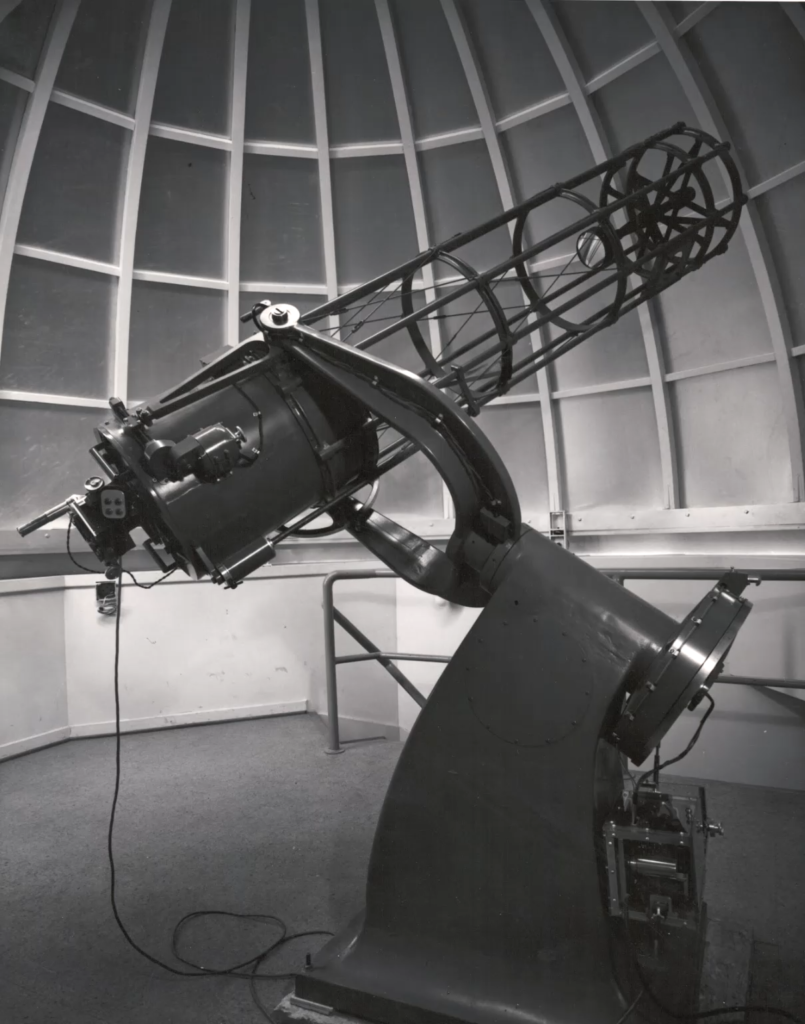

In November 2008, the college suffered major damage from the so-called “Tea” wildfire. One of the losses was the precious primary mirror of this telescope.
Today, what remains of Carroll’s gift is in retirement at Westmont, and “his” observatory has been replaced by a new building. It’s now home to the 24-inch Keck Telescope and is simply known as Westmont Observatory. (George Carroll’s contribution is still recognized on Westmont’s observatory webpage.)
30-inch Newtonian / Cassegrain
- - -
George Carroll, David Thomas, Sr., et al (Stony Ridge Observatory, Inc. Members)
Construction of this telescope – the largest that Carroll ever designed – took around 6 years to complete. It features an equatorial fork mounting system which is typical for scopes in this size range as mounts of the kind pictured above, so-called “German Equatorials” aren’t practical in the dimensions that would otherwise be needed and would greatly affect the housing considerations.
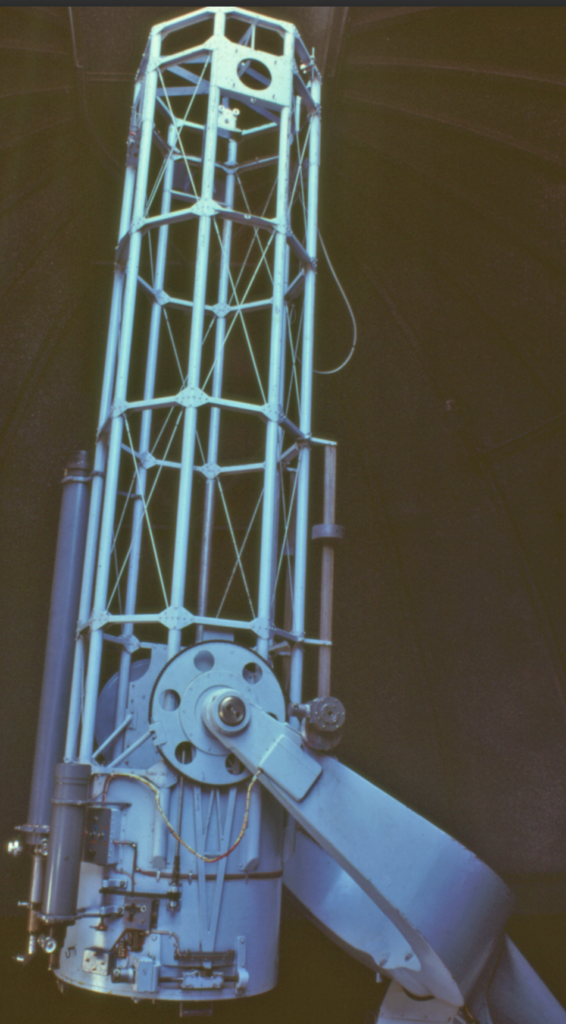
The "New" Stony Ridge 30-inch Telescope
This photo was taken in 1982, almost twenty years after the large, Stony Ridge reflector was put into service. Even still, it appears much the same as when it was commissioned in 1963. Although the mirror in this one has around twice the diameter of the 16.5-inch Newtonian pictured above, the scale of the required subordinate structures - the tube, the mount, the dome - required substantially more than a mere doubling of effort and provision.
George Carroll could be considered the father of this instrument, but to bring it and the observatory into existence called for a team of passionate, dedicated individuals. In essence, the Founding 15 were all "Telescope Makers."

The "New" Stony Ridge 30-inch Telescope
This photo was taken in 1982, almost twenty years after the large, Stony Ridge reflector was put into service. Even still, it appears much the same as when it was commissioned in 1963. Although the mirror in this one has around twice the diameter of the 16.5-inch Newtonian pictured above, the scale of the required subordinate structures - the tube, the mount, the dome - required substantially more than a mere doubling of effort and provision.
George Carroll could be considered the father of this instrument, but to bring it and the observatory into existence called for a team of passionate, dedicated individuals. In essence, the Founding 15 were all "Telescope Makers."
"Spars" and Other Solar Telescopes
- - -
George Carroll
“Spar” telescopes are designs in which the internal bracing of the enclosure (i.e., the “tube”) resembles the boxlike construction of an airplane wing and often affords for multiple, simultaneous optical paths. Otherwise, by use of intercepting optics, the light can be directed to a variety of positions, ostensibly to different sensors and instruments, some of which can be quite bulky and heavy.
Carroll also consulted with SRO Founder David Thomas on other, slightly more conventional solar scopes like the one pictured in the Thomas Tool and Die, Inc. brochure on page 7, a massive instrument weighing two tons when completely outfitted.
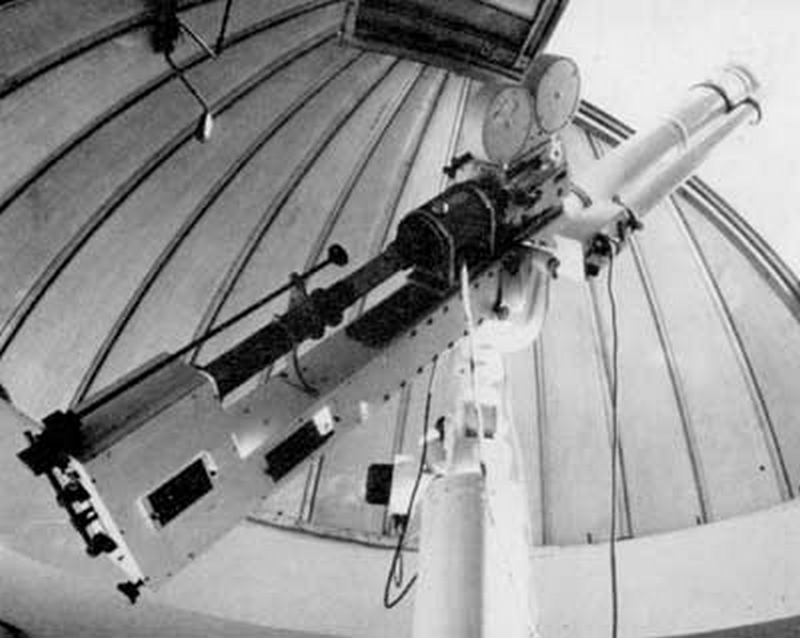
Spars - Telescopes That Need a Lot of Light
By 1969, Carroll had designed and constructed this telescope for solar studies at the University of Tel Aviv. Other spar telescopes were built and installed over Robinson Hall at the California Institute of Technology, Big Bear Solar Observatory, and Ottawa River Solar Observatory.

Spars - Telescopes That Need a Lot of Light
By 1969, Carroll had designed and constructed this telescope for solar studies at the University of Tel Aviv. Other spar telescopes were built and installed over Robinson Hall at the California Institute of Technology, Big Bear Solar Observatory, and Ottawa River Solar Observatory.
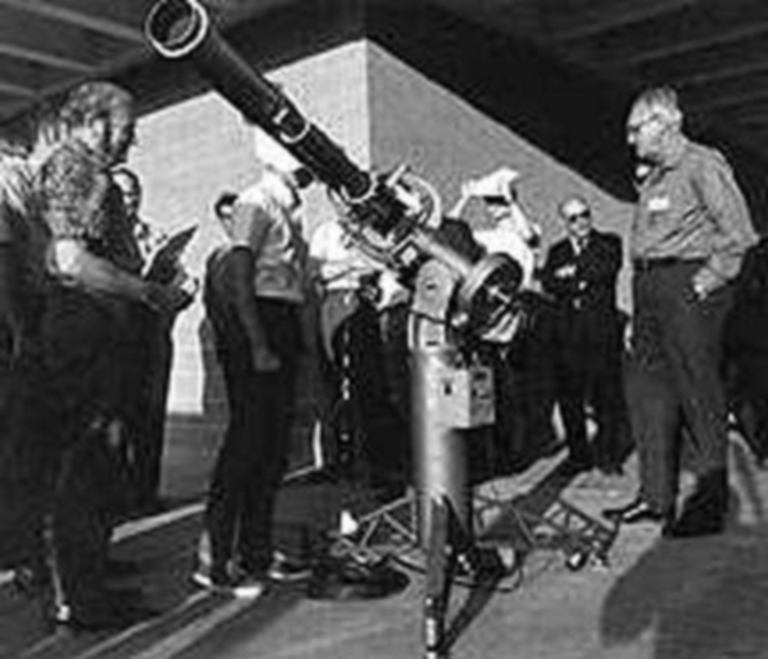
Solar observing greatly expands outreach opportunities for the obvious reason that more people tend to be awake in the daytime!
Here, George Carroll demonstrates one of his solar telescopes to interested observers young and old at the 1969 meeting of the Riverside Telescope Maker’s Conference.
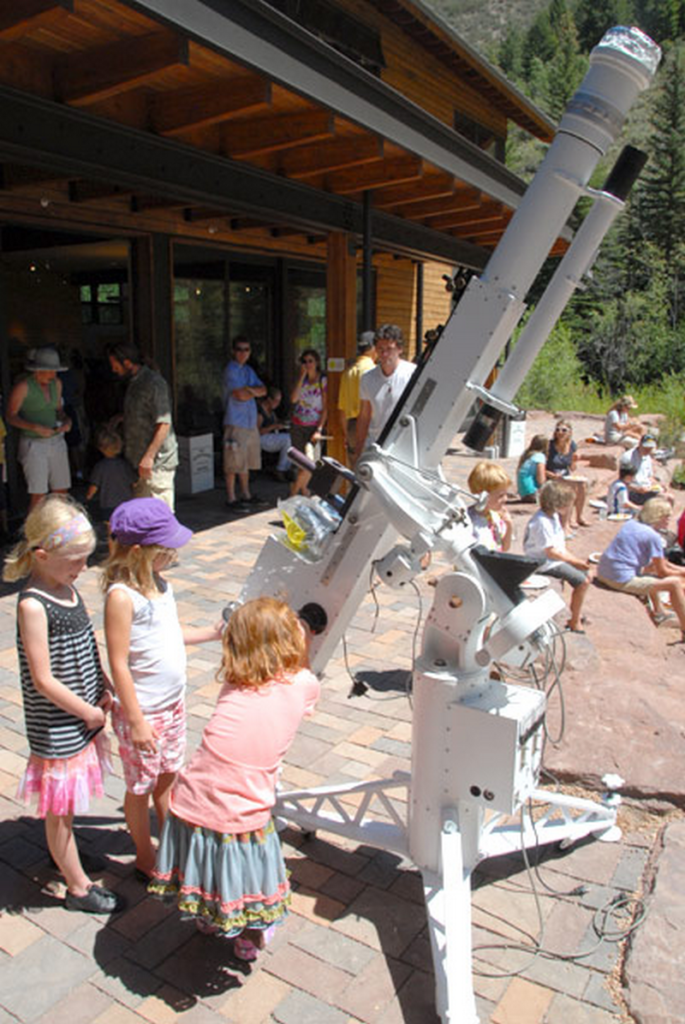
A Special Solar Scope
This 5-inch solar spar telescope was designed and built by George Carroll in 1974 at the Thomas Tool and Die Company. It was equipped with interchangeable components, field lenses and occulting disks to isolate prominences on the Sun's limb.
Destined for the Hopkins Observatory at Williams College (Massachusetts), it was dedicated to the memory Charles J. Hardy, Jr., late Chairman of American Car and Foundry Industries, in honor of his broad accomplishments there and as a distinguished alumnus of the Williams "Class of 1917."
John W. Briggs was to restore this telescope and intended to take it to Mt. Wilson for the transit of Venus in June 2012. It is seen here the previous year on August 20th at the public opening of the Walking Mountains Science Center in Avon, Colorado.

A Special Solar Scope
This 5-inch solar spar telescope was designed and built by George Carroll in 1974 at the Thomas Tool and Die Company. It was equipped with interchangeable components, field lenses and occulting disks to isolate prominences on the Sun's limb.
Destined for the Hopkins Observatory at Williams College (Massachusetts), it was dedicated to the memory Charles J. Hardy, Jr., late Chairman of American Car and Foundry Industries, in honor of his broad accomplishments there and as a distinguished alumnus of the Williams "Class of 1917."
John W. Briggs was to restore this telescope and intended to take it to Mt. Wilson for the transit of Venus in June 2012. It is seen here the previous year on August 20th at the public opening of the Walking Mountains Science Center in Avon, Colorado.







